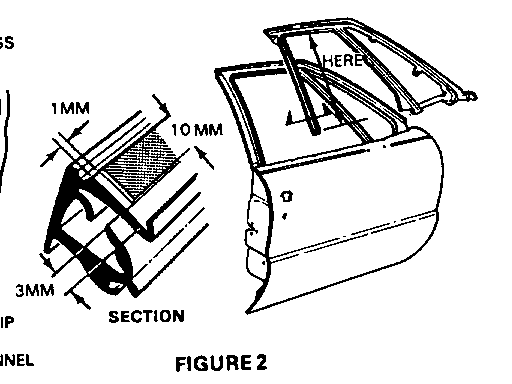WIND NOISE AT FRT. DOOR GLASS (ADD FOAM WEATHERSTRIP)

Subject: WIND NOISE AT THE REAR OF THE FRONT DOOR GLASS-B-PILLAR AREA (ADD FOAM WEATHERSTRIP)
Models Affected: 1992 BONNEVILLE MODELS
Some of the 1992 Bonneville models may exhibit a wind noise at the rear edge of the front door glass from the belt line to the roof.
CORRECTION:
---------- When the wind noise has been determined to be along the rear vertical edge of the glass, and gapping between the glass and the outer sealing strip of the glass run channel (see illustration) is evident, the following steps should be followed.
1. Lower the glass to the full down position.
2. Pull the rear vertical section of the glass run channel from the applique.
3. Add a thin strip of 3M Exterior Door Foam Weatherstrip Catalog No. 2104 or equivalent, as shown in the illustration. This foam tape material is available at most hardware and building supply stores. The foam tape should be approximately lmm thick and 10mm wide. Cut length to 450mm (17 1/2 inches) prior to attaching to the glass run channel. The foam tape should run from the top of the glass run channel to the bottom on the outboard side. When the run channel is reinstalled, the tape should shim the sealing lip out enough to contact the glass (see illustration).
4. Reinstall the glass run channel into the applique and cycle the glass several times (with engine running) to assure proper operation. Assure the gap between the glass sealing lip of the run channel has been eliminated.
WARRANTY INFORMATION:
Labor Operation No.: T5282 (one door) Labor Time: .2 hr. Labor Operation No.: T5283 (both doors) Labor Time: .3 hr.
Note: ---- For any part adjustment or replacement, use the appropriate Labor Operation from the Labor Time Guide. The above operation covers the foam tape correction only.


General Motors bulletins are intended for use by professional technicians, not a "do-it-yourselfer". They are written to inform those technicians of conditions that may occur on some vehicles, or to provide information that could assist in the proper service of a vehicle. Properly trained technicians have the equipment, tools, safety instructions and know-how to do a job properly and safely. If a condition is described, do not assume that the bulletin applies to your vehicle, or that your vehicle will have that condition. See a General Motors dealer servicing your brand of General Motors vehicle for information on whether your vehicle may benefit from the information.
